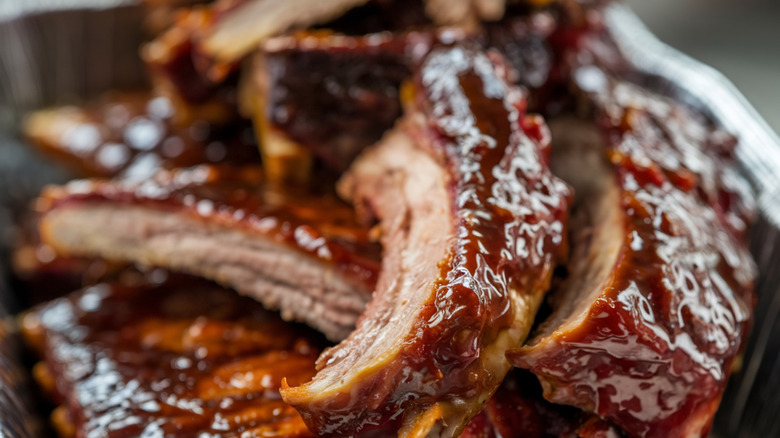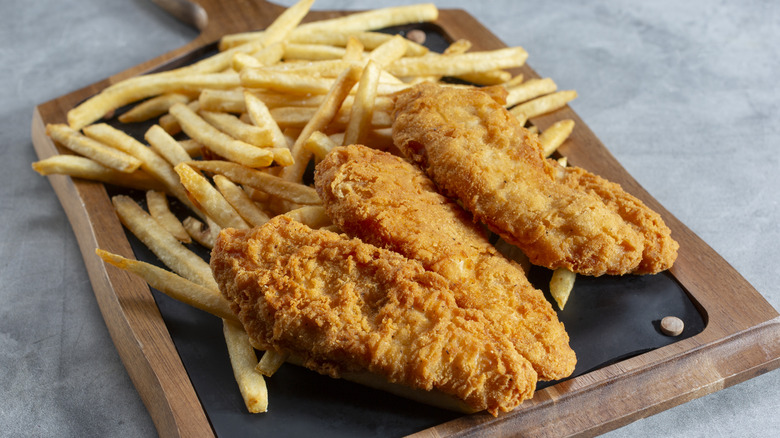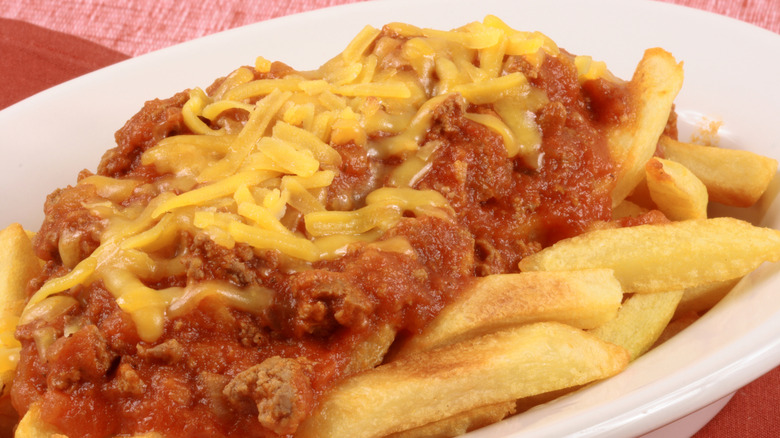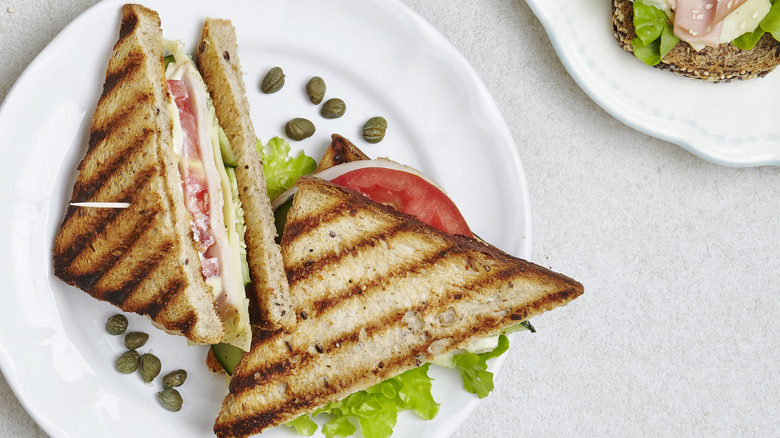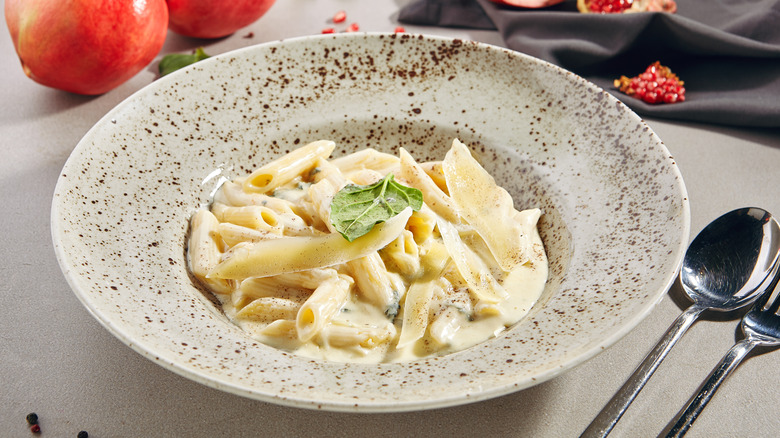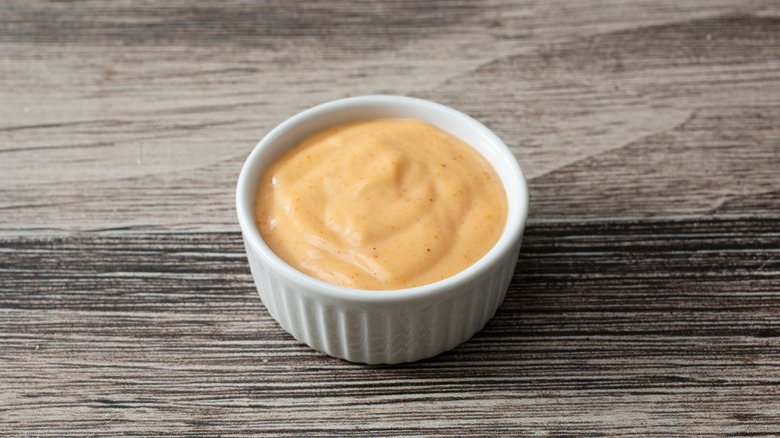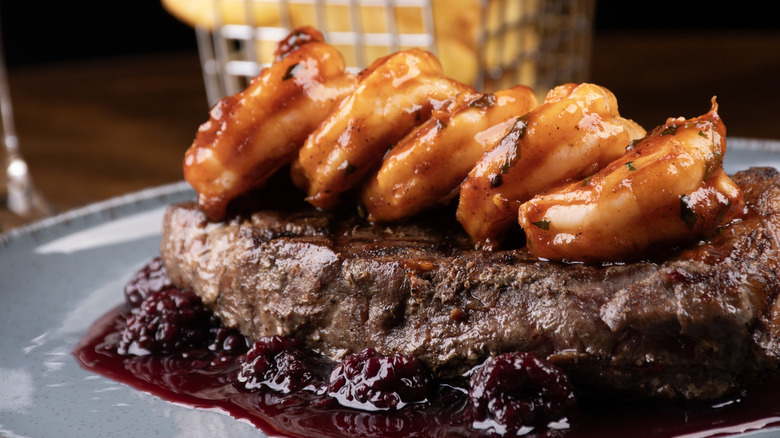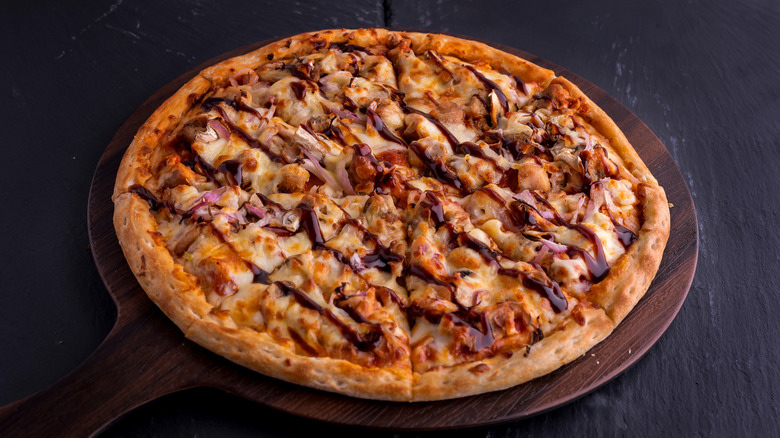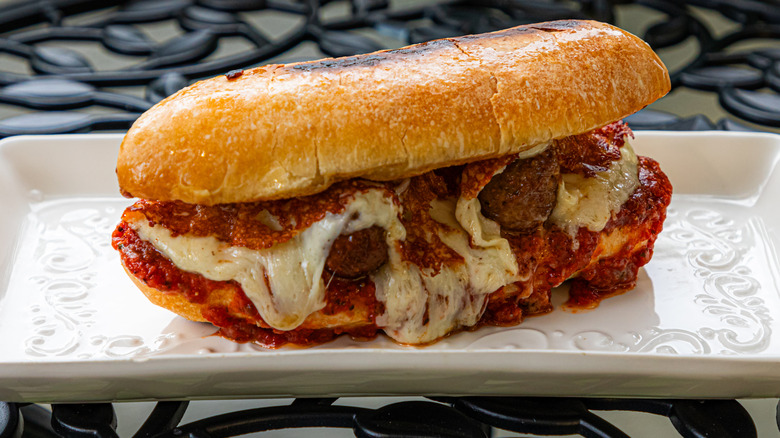Outdated Chain Restaurant Menu Items That Are Stuck In The 2000s
Surely it's not just us that think that chain restaurants need a revamp, right? While these restaurants can be charming, familiar, and affordable, they can also feel as though they're sorta stuck in a time warp — and nowhere is that more true than with their menus. Chain restaurant menu items can have a tendency to play it safe and appeal to the widest audience possible, but what this means in practice is that they churn out food that should have been modernized decades ago.
Honestly, we can understand why some places do this. The restaurant industry has had a rocky couple of years, and chains are fighting to keep customers happy and satisfied. As such, there's an inclination to play it safe, instead of risking too much with innovations that might alienate an audience that just wants something comforting. However, when you consider that a lot of restaurants have been growing their menus to give diners even more choice than ever, it feels strange that others have stuck to serving items that would have been popular in the noughties, but now just feel stale. Wondering what these items are? We've got them all right here.
Baby back ribs
2003 called, it wants its ribs back. Baby back ribs have been on menus for roughly a century now, but something about them feels emblematic of the early noughties, right? If you had to ask us, we'd say it's a combination of the excess of a massive rack of ribs, and the cloying sweetness that so many restaurants put onto their meat, that evokes a sense of the 2000s. Sure enough, plenty of chain restaurants are still hanging onto this as a core offering, and places like LongHorn Steakhouse and Applebee's serve enormous slabs of baby back ribs smothered in sticky, smoky sauce.
Now, don't get us wrong: Every now and again, baby back ribs really hit the spot. However, a lot of the time, they just feel over-the-top and overly messy. You need a pile of tissues to get through them, and so often restaurants drastically overcook their ribs, turning them into a chewy pile of tough meat. That's not to say that we don't love ribs as a food — there's nothing like a perfectly cooked short rib, with its meat falling off the bone — but this style of restaurant baby back ribs just feels stuck in the past.
Chicken tenders
Okay, so before you all come for us: We love chicken tenders. Like, really love them. They're meaty, they're crunchy, they're perfect for dipping into an assortment of sauces, and they often feel way less heavy than other types of fried chicken. However, there's no denying that they're a menu item that really needs an update.
Our problem with chicken tenders is that restaurants always serve them in exactly the same way, and have done for the last few decades. Whether you're in Applebee's or Red Robin, you'll be getting the same thing: A selection of salty, vaguely spicy tenders, some fries, and a creamy dipping sauce.
Sometimes that's all you need, but isn't it a pretty boring way of approaching your meal? We wish that chain restaurants would take more of a risk with these and make exciting varieties like French onion chicken tenders or tenders smothered in sweet-spicy gochujang. As it stands, though, very few chain joints are doing that, and instead are cranking out the same old stuff. It's time to mix things up, guys — no matter how much we love our tendies.
Chili cheese fries
If ever there was a chain restaurant menu item that was languishing in the 2000s, it's chili cheese fries. These fries may be great after a night out, but they've barely changed since the turn of the millennium. A pile of fries with a pile of chili and a pile of cheese on top. Can we get a little bit of variation here? Sadly, no: Everyone from Wendy's to Sonic are serving their chili cheese fries in exactly the same way, with little variation or innovation going on.
We know that's kind of the appeal of chili cheese fries (that they taste the same, no matter where you go), but we can't get past the feeling that they feel a bit like an outdated abomination. When made with care and love, chili is a complex, dynamic, exciting dish, with layers of flavor that reveal themselves with every bite. The chili that ends up on chili cheese fries, however, is usually fairly flat and salty. Furthermore, they often opt for American cheese or a kind of Cheez Whiz, which has none of the sourness and maturity needed to make a good chili pop. This side dish either needs a rethink or a removal from menus.
Club sandwich
So, we know that club sandwiches have been around for longer than the 2000s. However, it's undeniable that they have a whiff of the noughties about them. Club sandwiches first started appearing in the late 19th and early 20th century, but it took a while for them to become a chain restaurant staple. When they did, though, they did so with gusto, and today The Cheesecake Factory and Applebee's still serve them proudly on their menus. Even to this day, they feel like the kind of thing you'd tuck into while watching the last episode of "Friends."
There's definitely a coziness and a nostalgia about club sandwiches, but they also feel pretty unadventurous by today's standards. There are some incredible chain restaurant sandwiches out there, which go way further than the bacon, turkey, chicken, and cheese that club sandwiches generally offer. Take Call Your Mother's "Hidden Cove" bagel, which piles a sesame seed bagel full of smoked salmon, avocado, nori, carrots, and marinated cucumbers. It's fresh, it's zesty, and it feels like a sandwich which is serving what folks want today, instead of one that's repeating the same old flavors.
Multiple-cheese pastas
One cheese is good, but more cheese is better. That's the philosophy that so many chain restaurants used to follow, and still do by the looks of their menus. Multiple-cheese pastas used to be all the rage, but now they feel like menu items that are clunky and past their prime. It's also kinda wild how many cheeses some chain restaurants manage to get into their pasta dishes. Applebee's has a Three-Cheese Chicken Penne, while Maggiano's offers a Four-Cheese Ravioli, which is served in a parmesan cream (we think that makes it five, but who's counting? Oh yeah, we are). Meanwhile, Olive Garden's Five Cheese Ziti al Forno shoves virtually every dairy item under the sun into the mix.
The issue with these pasta dishes is that they feel like a relic of a time when bigger was better, and this often came at the expense of delicacy and taste. Pasta dishes aren't really meant to be maximalist and over-stuffed with items. Instead, the best pasta chefs understand that a good dish can be made by using just a few quality ingredients, which exist in harmony with each other and with each one allowing every flavor within to breathe. These multiple-cheese pastas just overdo it.
Spicy ranch
If we had to put our fingers on it, the ranch explosion reached its peak in the 2000s. This was the moment when people started to get tired of ranch as it was and experimented with various flavors that could make this already exciting dressing even more flavorful. Enter spicy ranch, a dip that takes the flavor of ranch and perks it up, cutting through the creaminess with a touch of fire. Today, while you'll find ranch everywhere, you're more likely to find its spicy siblings in chain restaurants that specialize in Tex-Mex cuisine, with Taco Bell and Chipotle having their own versions.
Spicy ranch is definitely tasty, but unfortunately, it just doesn't hit the spot like it used to. There's something just a little bit boring about its flavors in a world where you can find pretty much any dip you like under the sun. We prefer dips with a touch more excitement to them these days, which combine ranch with new and dynamic flavors that bring your dish to life.
Surf & Turf
There's no denying that surf & turf is retro, guys. A few decades ago, it was all the rage and felt like it spoke to turn-of-the-century excess. Cut to 2025, though, and it's still everywhere in a way that feels incomprehensible. Steakhouses still offer surf & turf to their customers, including Ruth's Chris, Del Frisco's, and Outback Steakhouse.
We feel like surf & turf feels a little like piling everything on a plate and hoping for the best. We've never been totally convinced by the flavor dynamic that steak and seafood provide: The beef is too heavy for the delicate seafood, and tends to overwhelm it. It's not helped by the fact that the classic side dishes that you use to elevate your steak are also typically fairly weighty, leaving you with a bunch of rich food with a light accompaniment that's totally drowned by the whole experience. That kind of subtlety was lost in the 2000s, but nowadays we're more aware of it.
BBQ chicken pizza
Few pizzas throw us back to the 2000s like BBQ chicken pizza. This was the decade that pizza got brave, and while the original BBQ chicken pizza was created way back in 1985 by California Pizza Kitchen, it didn't quite take off until a decade or two later. By the noughties, it felt like every pizza place was serving it, and to this day plenty of them still do, with BJ's featuring a deep dish barbeque chicken pizza on its menu that's guaranteed to overwhelm. California Pizza Kitchen, meanwhile, still proudly displays its original invention on its menu.
We have to admit that we're big fans of BBQ chicken pizza; the barbeque sauce elevates the lighter flavors of the chicken in an exciting fashion, while the red onions and cilantro peppered over each pie provide a sense of lightness. However, it's also undeniable that this is a menu item that hasn't had an update in about 40 years. We guess you could argue that if it ain't broke, you don't need to fix it, but when you consider how diverse the world of barbecue is, we feel that restaurants are missing a trick. We'd love to see a pizza base with Alabama's white BBQ sauce, or Carolina gold sauce — but we guess we'll have to keep dreaming.
Asian chicken salad
Of all the menu items that should have been left on the other side of the 2010s, Asian chicken salad is one of them. For some reason, this salad was everywhere in the 2000s. Perhaps this was the decade where people realised that Asian-inspired cuisine didn't have to be limited to dishes we commonly associate with Chinese, Japanese, and Korean food, but instead could be fused with other styles to make something new. Salad was the primary target for this fusion, and Asian chicken salads started to pop up everywhere, with The Cheesecake Factory and Panera still featuring them on their menus.
The extent to which these salads can be convincingly described as Asian cuisine, however, is up for debate. Asian chicken salads are typically a combination of grilled chicken, lettuce, and wonton strips, with additions like bean sprouts, sesame dressing, and almonds also being common. While the flavor is tasty and easygoing, this salad feels like a basic, catch-all, and distilled version of Asian-influenced food that now seems very outdated and ill-considered. Our understanding of Asian cuisine and its availability has moved on leaps and bounds in the last 20 years. Why would you order this if you could get something authentic and unique elsewhere?
Meatball sub
We've got a lot of love for the meatball sub, but in its classic form, it's very clearly a sandwich of a different era. Meatball subs feel like they come from the same world of Razor scooters and Limp Bizket, with their brash, bolshy flavors perfectly mirroring the feel of the noughties. Given their heartiness for the price you normally pay, it's little wonder that a lot of sandwich chains still sell meatball subs (Firehouse Subs, Potbelly, and Subway all still sell them by the bucketload in their restaurants), and we doubt that they're going anywhere soon.
We would argue, though, that there's a better way to do this sandwich. Back in the 2000s, it felt like it was enough to just heap a pile of saucy meatballs onto thin, flimsy bread and hope for the best. In practice, what would happen is that the sauce would soak through your sub, leaving you with a gloopy mess after the second bite. Not much has changed today, unfortunately: These subs are still cumbersome, messy, and feel weirdly rich. In the last 20 years, we've figured out how to make bread a central feature of a sandwich instead of just a vehicle for the ingredients, and to balance the filling so it doesn't overwhelm everything. Meatball subs haven't quite nailed that just yet.

